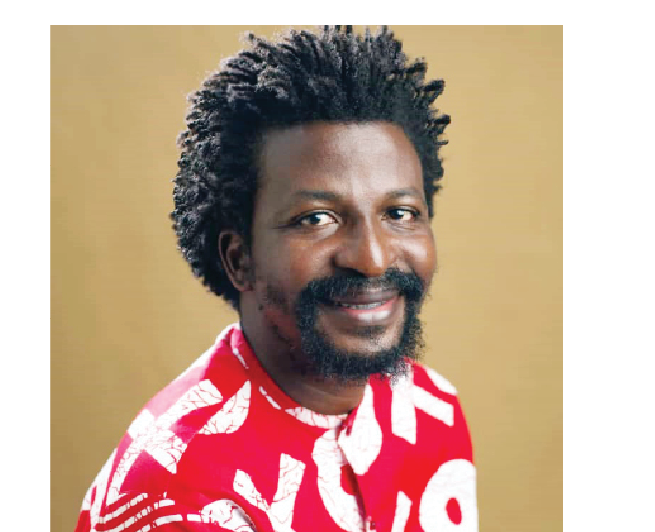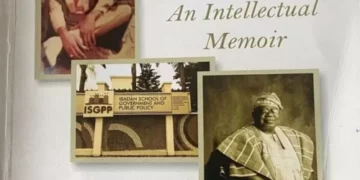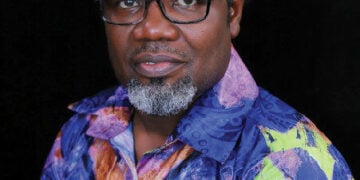Absa L’Atelier, in collaboration with the South African National Association for the Visual Arts (SANAVA), recently hosted Thorns and Crown, a solo exhibition by Badru Taofeek, one of the 2022 Absa L’Atelier Ambassadors. Held at Alliance Française in Lagos as part of Absa’s 2025 Pan-African Gallery Exhibition Series, the show spotlighted rising African contemporary art voices.
Despite heavy rain, a large crowd gathered to experience Taofeek’s richly layered collection of hand embroidery, bronze sculpture, and textile installations. The artworks explored the emotional landscape of leadership, balancing reverence with responsibility.
With captivating visual arts hung on the walls, which depict talent, ingenuity, creativity and tradition, the arts enthusiasts and invited guests had a mind blowing experience at the Alliance Française in Lagos where, richly-layered collection of hand embroidery, bronze sculpture and textile installations by Badru Taofeek showcased an emotional landscape where reverence and responsibility coexist.
“Thorns and Crown’” is a deeply reflective body of work aiming at interrogating the unseen labour of leadership and the delicate balance between visibility, expectation and inner struggle.
Leadership is often adorned with prestige and reverence, yet beneath its splendour lies an unspoken narrative of burden, sacrifice and internal conflict. Thorns and Crown unravels this tension and explores the unseen weight of authority through a series of hand embroidery, textile installations and bronze works.
At the exhibition is the Yoruba beaded crown, a powerful emblem of leadership, cultural heritage and influence. While it radiates honour, its intricate beadwork hints at the quiet struggles that accompany positions of power. Through meticulous craftsmanship and layered symbolism, Thorns and crown explained the paradox of success, where admiration and responsibility are inseparably intertwined.
By blending embroidery, textile manipulation and abstraction, Thorns and Crown of power will challenge you to look beyond the visible symbols of power. It prompts a deeper contemplation of what it means to lead: to carry the crown but also to bear its thorns.
In its 39th year, ABSA L’Atelier, one of Africa’s longest-running and most prestigious visual arts development programmes, has supported its Ambassadors, Badru Taofeek inclusive, with funding, mentorship and a fully sponsored solo exhibition, serving as a professional platform designed to elevate their practice and bring their stories to new audiences – as part of its L’Atelier journey.
The artworks were neatly displayed, which complemented the shining white background of the exhibition wall. The setting was tasteful as there was enough room in between the artworks displayed.
As each of the art enthusiasts were moving around to view the works, the excitement on their faces was a testament of Taofeek Badru’s talent and ingenuity. There were about three triptych artworks. A triptych is an artwork, usually a painting or photograph, formed as a trio.
And each of the triptych artworks were displayed separately which helped art enthusiasts present at the exhibition to have a better appreciation of the works.
Indeed , the attendees discovered Badru’s latest break-through art as he shared his story in the beautifully curated exhibition as dazzled eminent art lovers and users at the event that put on the shelf drawings that speak.
Present at the event were Country CEO of Absa Group Sadiq Abi; Marketing Executive, Alliance Française de Lagos, Precious Naador, chairman, Absa Group, Nigeria, Adedotun Sulaiman, and other dignitaries.
The brain behind these captivating visual arts is not a new kid on the block, Badru Taofeek’s works have traversed the length and breadth of the continents showcasing his talents.
Badru, who was one of the 2022 ABSA L’Atelier Ambassadors has made it once more through the support of the two big leading international bodies.
Sadiq Abi, CEO of Absa Nigeria, praised the exhibition as “more than an exhibition, it is a mirror, one that shows us the duality of leadership in admiration, and its weight, its honor, and its burden.” He added, “Badru has gifted us something rare, a deeply personal yet universally recognized body of work… He has elevated a local narrative into a global conversation.” Abi emphasized Absa’s commitment to artist development: “ABSA L’Atelier is not just about visibility, it is about development… We at ABSA are proud to be a part of their journey.”
Adedotun Sulaiman, Chairman of Absa Group Nigeria, highlighted the synergy of commerce and creativity in supporting artists. “For us at ABSA, your story matters and art is about storytelling… We hope to see Badru transform into an artist of international repute and a worthy ambassador for Nigerian creativity.”
Dr. Paul Bayliss, ABSA’s Art and Museum Curator, noted the balance in Taofeek’s work between technical mastery and conceptual depth: “He’s used embroidery, a technique many artists don’t use… His work forms a conceptual perspective looking at the role of leadership, the weight that the leader has to carry and the responsibility that comes with leadership.”
Representing Alliance Française, marketing executive Precious Naador emphasised the importance of partnership and audience exchange, encouraging support for Taofeek’s work through purchases and collaborations.
In his words, the artist, Taofeek Abiodun Badru from Abeokuta in Ogun state, Nigeria, explained how his work, “Thorns and Crown”, reflects the dual leadership especially in the political context in Nigeria and Africa.
“Behind the success, behind the leadership role… there is a struggle beneath. Just as you cannot like roses without the thorns, if you like roses, you have to embrace the thorns.” He described the exhibition as a response to social media’s focus on success without acknowledging struggle.
He also connected his art to broader Pan-African themes of identity, vulnerability, and tradition: “Everybody wants Africa, Nigeria to be developed, but it comes with challenges… You cannot want Lagos to be like New York and not obey simple traffic rules. It has to come with being ready to face the struggle.”
Taofeek shared his artistic journey from Abeokuta’s Adire tradition to his studies at Obafemi Awolowo University, blending embroidery, bronze, and textile installation techniques. His work incorporates Adire-like patterns as symbolic communication.
On the exhibition’s title, he recalled a viral video of a man praying to be like Dangote, Nigeria’s richest man, and questioned if he was ready for the challenges that come with such success. “There are challenges that come with all these things… I am the only artist exhibiting here today. So, these are the challenges.”
He described his main artwork as a triptych (three works as one), symbolising life’s pivotal moments that change destiny and bring recognition.
“I think it relates to everything in general. I try to let us know that behind the success, behind the leadership role, behind the achievement, behind the glamour, there is a struggle beneath. Just as you cannot like roses without the thorns, if you like roses, you have to embrace the thorns.
“So, with this exhibition, I am trying to let us know that, especially in this social media era, where people only post their success story and their finished work. I am trying to let us know that there is struggle underneath it.
On how it contributes to the broader pan-African narratives of identity, vulnerability and tradition, he said, “It contributes to the extent that we have to know that you cannot eat your cake and have it. For example, everybody wants Africa, Nigeria to be developed, but it comes with challenges. You cannot want Nigeria or Lagos to be like New York, to be like London and not obey simple traffic rules. It has to come with being ready to face the struggle that will come with development.”
On what inspires his creative process and how he draws ideas from his experiences and surroundings.
“To get inspiration in this age now, I think it is very simple. So many things are happening at the same time in Nigeria and in Africa. So many struggles are going on. Everybody wants to become a celebrity now. So, the inspiration comes from all these things. Listening to news daily, listening to what is happening through our music, through the media and on,” he said.
On his artistic journey and the evolution of his styles, he said, “I started my art journey in Abeokuta. I went to Federal College of Education, Osiele. After that, I went to Obafemi Awolowo University (OAU) for my first and second degree. So, this is the process of my journey. I am from Abeokuta.
“Abeokuta is known for the Adire practice. And when you look at my work, you will see some Adire-like patterns there. Those patterns are like communication symbols. They have their own different meanings. And my techniques are hand embroidery, bronze and sculpture, textile installation,” he said.
He added that he chooses the themes he explores in his artwork, “Just like I have a general theme for the whole exhibition. So, under this general theme, which is Thorns and crowns, I now have titles for different art pieces. Talking about what I am trying to say through the main title, which are thorns.
On his title “Thorns and crown” for the work, he relieved the specific incident that inspired the titling.
“So many circumstances inspired this theme. One of them would be one film that I saw online. I think the guy went to the Holy Land, Mecca. He was now praying at the Ka’aba: ‘I want to be Dangote. I need money like Dangote.’ When I saw the video, I was like, if God answers this prayer, is this man ready for the challenges that will come with being Dangote, the richest black man? Because there will definitely be challenges that will come with it.
“So, when you look at social media, everybody wants to be celebrated. Everybody wants to trend. No matter how crazy that will go. So, I am trying to let us know that there are challenges that come with all these things. And even being here now, I am the only artist exhibiting here today. So, these are the challenges.
Explaining his work of art. “The work is actually three in one. In art, we call it diptych. So, it is when three works come together as one. So, it is not possible for somebody to buy one of these. You have to buy the three.
“So, I am trying to relate it to our normal life now. In the journey of life, there will be a certain period, that something happened to you that changed your destiny. For example, maybe as I am here now, exhibiting now. Maybe one celebrity comes here and uploads one work. And from there, a big art collector saw the work and bought it. It brings expansion, recognition and rewards. Badru thanked the sponsors for their support for ‘believing in him and his craft.





